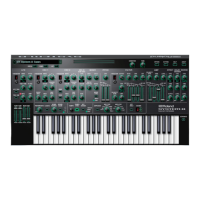14
Step Sequencer
Playing the Step Sequencer
1. Press the [EDIT/DISP] button to make it light.
2. Press the [START] button.
The step sequencer data plays.
STEP SEQ T=120.0
*
- 1-16 À
Step
1–16
Step
17–32
Step
33–48
Step
49–64
Shown on
the panel
(step buttons)
Steps shown
on the panel
(step buttons)
Currently
playing
Tempo
Outside the
STEP LENGTH
range
The “*” indicates the area of steps (1–16, 17–32, 33–48, 49–64)
shown by the STEP [1]–[16] buttons.
The “
9
” indicates the area of steps that is currently playing.
MEMO
5 You can use the cursor [
K
] [
J
] buttons to change the area that
is shown on the panel (step buttons).
5 When the [EDIT/DISP] button is lit, you can hold down the
[SHIFT] button and press one of the STEP [1]–[4] buttons to
change the area of steps from which to select.
3. To stop, press the [START] button once again.
[1]–[16] buttons
Displays the status of each step.
Button color Meaning
Blue Currently-playing step
Green Step that contains performance data
White Step that contains no data/Muted step
Muting a Specic Step (STEP MUTE)
The STEP [1]–[16] buttons show the status of each step in the
selected area of steps (STEP: 1–16, 17–32, 33–48, 49–64).
1. Press the button of the step that you want to mute.
That step is muted, and the button is lit white.
2. To unmute the step, once again press the button of
the muted step.
Specifying the Note Value of a Step (SCALE)
1. Turn the [SCALE] knob.
Indication Explanation
1/8 Eighth note
1/16 Sixteenth note
1/32 Thirty-second note
1/4T Quarter-note triplet
1/8T Eighth-note triplet
1/16T Sixteenth-note triplet
Specifying How the Step Sequencer Plays
(PLAY MODE)
1. Turn the [PLAY MODE] knob.
Indication Explanation
Play forward from the rst step.
Play backward from the last step.
Play forward from the rst step, and then play
backward from the last step.
Play with even-numbered and odd-numbered steps
inverted.
RND Play steps randomly.
KEY TRIG Play normally while the keyboard is held.
Changing the Note Duration (GATE)
You can adjust the duration of the note recorded at each step.
Turn the [GATE] knob toward the right
The gate becomes longer.
Turn the [GATE] knob toward the left
The gate becomes shorter (staccato). In some cases, turning the
knob all the way to the left might make the note too short to hear.
Changing the Swing (SHUFFLE)
You can adjust the timing of the notes for even-numbered steps
(Step 2, Step 4, Step 6...).
If the knob is in the center position, the timing is not adjusted.
Turn the [SHUFFLE] knob toward the right
Higher values delay the timing of the notes.
Turn the [SHUFFLE] knob toward the left
Lower values advance the timing of the notes.

